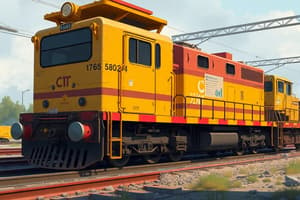Podcast
Questions and Answers
What component is responsible for the lifting and lowering of tamping units?
What component is responsible for the lifting and lowering of tamping units?
How can the opening width of tamping tools be adjusted for joint sleepers?
How can the opening width of tamping tools be adjusted for joint sleepers?
What are Tungsten Carbide Tamping Tools (TCTT) used for?
What are Tungsten Carbide Tamping Tools (TCTT) used for?
Which unit is positioned in front of the tamping units to handle lifting and lining?
Which unit is positioned in front of the tamping units to handle lifting and lining?
Signup and view all the answers
What is the function of the satellite unit in continuous sleeper tamping machines?
What is the function of the satellite unit in continuous sleeper tamping machines?
Signup and view all the answers
What is the primary role of trolleys in the tamping process?
What is the primary role of trolleys in the tamping process?
Signup and view all the answers
Which component is NOT part of the tamping unit layout?
Which component is NOT part of the tamping unit layout?
Signup and view all the answers
What affects the quality of compaction during tamping?
What affects the quality of compaction during tamping?
Signup and view all the answers
What is the primary function of the 09-32 CSM Plain Track Tamper?
What is the primary function of the 09-32 CSM Plain Track Tamper?
Signup and view all the answers
How many tamping tools does the Tamping Express (09-3X) have?
How many tamping tools does the Tamping Express (09-3X) have?
Signup and view all the answers
What type of operation does the tamping mechanism use?
What type of operation does the tamping mechanism use?
Signup and view all the answers
What system does the 09-32 CSM use for levelling?
What system does the 09-32 CSM use for levelling?
Signup and view all the answers
What is the range of squeezing forces applied during the tamping process?
What is the range of squeezing forces applied during the tamping process?
Signup and view all the answers
What is one of the main advantages of using the Tamping Express compared to the 09-32 CSM?
What is one of the main advantages of using the Tamping Express compared to the 09-32 CSM?
Signup and view all the answers
Which component is crucial in the tamping units as per the provided content?
Which component is crucial in the tamping units as per the provided content?
Signup and view all the answers
How many sleepers can the 09-32 CSM tamp at a time?
How many sleepers can the 09-32 CSM tamp at a time?
Signup and view all the answers
What type of vibrations do the tamping tools use during their operation?
What type of vibrations do the tamping tools use during their operation?
Signup and view all the answers
What is the primary purpose of the tamping tools during operation?
What is the primary purpose of the tamping tools during operation?
Signup and view all the answers
What is the purpose of the correction FD in the 4 Point Lining method?
What is the purpose of the correction FD in the 4 Point Lining method?
Signup and view all the answers
How is left over error FR calculated?
How is left over error FR calculated?
Signup and view all the answers
What does the variable 'n4pt' represent in the context of reducing errors in lining?
What does the variable 'n4pt' represent in the context of reducing errors in lining?
Signup and view all the answers
In the 4 Point Lining method, what should be done after calculating the value of FD?
In the 4 Point Lining method, what should be done after calculating the value of FD?
Signup and view all the answers
When might the ratio of H1/H2 not hold true during the lining process?
When might the ratio of H1/H2 not hold true during the lining process?
Signup and view all the answers
What does the squeezing time refer to in the tamping cycle?
What does the squeezing time refer to in the tamping cycle?
Signup and view all the answers
When does the squeezing action commence during the tamping process?
When does the squeezing action commence during the tamping process?
Signup and view all the answers
What should be done with tamping tools that have more than 20% wear of their original surface area?
What should be done with tamping tools that have more than 20% wear of their original surface area?
Signup and view all the answers
At what distance before the zero position does the lifting and lining circuit operate once the tamping unit is raised?
At what distance before the zero position does the lifting and lining circuit operate once the tamping unit is raised?
Signup and view all the answers
What is the adequate squeezing time range for maintenance packing?
What is the adequate squeezing time range for maintenance packing?
Signup and view all the answers
What happens to the circuit when the preset squeezing time is completed?
What happens to the circuit when the preset squeezing time is completed?
Signup and view all the answers
Which of the following optional equipment aids in reducing errors during data collection?
Which of the following optional equipment aids in reducing errors during data collection?
Signup and view all the answers
How is the lowering of the tamping unit set to commence during a normal cycle?
How is the lowering of the tamping unit set to commence during a normal cycle?
Signup and view all the answers
What action follows the squeezing and holding phase in the tamping cycle?
What action follows the squeezing and holding phase in the tamping cycle?
Signup and view all the answers
What does the Geometry Value Assessment (GVA) optional equipment assist with?
What does the Geometry Value Assessment (GVA) optional equipment assist with?
Signup and view all the answers
What role does the measuring trolley B serve in the alignment process?
What role does the measuring trolley B serve in the alignment process?
Signup and view all the answers
What is the purpose of the wire stretched between points A and D?
What is the purpose of the wire stretched between points A and D?
Signup and view all the answers
How does the machine perform curve correction?
How does the machine perform curve correction?
Signup and view all the answers
What does the versine ratio 'i' represent in the context of the machine's operation?
What does the versine ratio 'i' represent in the context of the machine's operation?
Signup and view all the answers
Which point is responsible for making corrections to the alignment during operation?
Which point is responsible for making corrections to the alignment during operation?
Signup and view all the answers
What measurements are taken at trolley locations B and C?
What measurements are taken at trolley locations B and C?
Signup and view all the answers
What do the theoretical versine measurements H1 and H2 indicate?
What do the theoretical versine measurements H1 and H2 indicate?
Signup and view all the answers
In the alignment process, how is the outer rail utilized?
In the alignment process, how is the outer rail utilized?
Signup and view all the answers
Which trolley location represents the area where correction is physically applied?
Which trolley location represents the area where correction is physically applied?
Signup and view all the answers
What does the fork connection in the measuring system facilitate?
What does the fork connection in the measuring system facilitate?
Signup and view all the answers
Study Notes
Tamping Unit Components
- The tamping unit consists of components such as the tamping bank, center pin, big tamping arm, big squeezing cylinder, and guide rod.
- The tamping tools are responsible for the compaction of ballast and their size and shape impact the quality of compaction.
- The lifting and lining unit is positioned in front of the tamping units and uses a lifting cylinder with roller clamps or hooks to lift and align the track.
- The satellite unit is used for continuous sleeper tamping machines and is capable of independent movement from sleeper to sleeper.
- Trolleys are wheeled units with sensing feelers used for track parameter measurement and correction.
- There are different models of tamping machines, including the 09-32 CSM and Tamping Express (09-3X), which can tamp two or three sleepers simultaneously.
Tamping Mechanism
- The tamping process utilizes the asynchronous constant pressure tamping principle.
- Tamping tools perform sinusoidal vibrations to press ballast until a desired force is reached.
- Tamping tools move for different durations, pressing the ballast until desired pressure is reached.
- This asynchronous action ensures constant pressure application on the ballast.
Tamping Cycle
- A complete tamping cycle includes: lowering the tamping unit, squeezing ballast, holding the tamping tools, releasing, and lifting the tamping unit.
- Squeezing time is the time taken to compact the ballast using preset pressure.
- The tamping cycle typically starts with a lowering of the tamping unit by 100mm. The squeezing action commences 30mm before the tamping tools reach their target depth.
- The squeezing process continues based on preset squeezing time, after which the tamping unit lifts.
- Lifting and lining operations are cut off when the tamping unit is 100mm from its zero position.
Tamping Tool Surface Area
- The surface area of tamping tool blades varies among different machines.
- Tools with wear exceeding 20% of the original surface area should not be used.
- Worn out tools are reconditioned or replaced.
Optional Equipment
- Optional equipment such as laser beam system, geometry value assessment (GVA), and ALC enhance efficiency and reduce manual error.
- The laser beam System uses photocells to receive a laser beam from an emitter, allowing for precise measurement and correction of track alignment.
- Four points in the machine are used for measurement: rear trolley location (A), measuring trolley location (B), lining trolley location (C), and front trolley location (D).
- Trolleys are pressed against the outer rail for reference.
- Versine ratio is used for calculating theoretical and actual versines based on the distance between trolleys.
- The lining operation is adjusted by slewing point C to ensure the correct versine ratio.
Corrections in 4 Point Lining Method
- The 4 Point Lining method requires correction for errors arising from front trolley location on disturbed track and variable curvature.
- The residual error in the lining point C is calculated based on the error at the front trolley and trolley distances.
- A correction equal to the front trolley error is applied at the front tower to eliminate this error and achieve accurate track alignment.
Studying That Suits You
Use AI to generate personalized quizzes and flashcards to suit your learning preferences.
Related Documents
Description
This quiz explores the various components and mechanisms of tamping units used in railway maintenance. It covers the roles of elements such as the tamping bank, lifting units, and different tamping machines. Test your knowledge of the tamping process and its impact on track quality.




